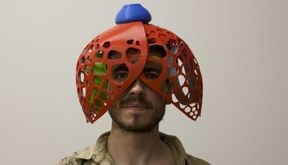Andrea Mancianti: Inventing VR Blindphones

Andrea Mancianti, a doctoral researcher at Aalto University, worked on a very challenging and fascinating project all summer. From 6 to 10 September, the researcher himself has travelled to Linz, Austria for the Ars Electronica Festival, where he presented his innovation. Mancianti's innovation is a virtual reality helmet used for music, allowing the user to experience a composition piece in a whole new, more whole-body-experience way. Blindphones, as Mancianti calls the invention, limit a user’s sight, and enhances one's listening.
From composer to researcher
Before going into further detail of Mancianti’s object, it is crucial to understand his background and motivations for getting into this kind of research. Born and raised in Italy, Mancianti attended Conservatory of Florence to study composition and music technology. After that, he worked as a freelance composer. As classical music started to feel too narrow for Mancianti, he moved to Finland to enroll in Aalto University as a PhD candidate at the Department of Media, researching embodied performative applications of virtual reality, VR.
Unleashing sonic potential of VR
Mancianti started working on this project in January, as his supervisor, professor Lily Diaz-Kommonen, was teaching the course "Systems of representation". Diaz-Kommonen engaged in a conversation with the biochemistry department about a potential research project, and soon the collaboration started. Mancianti was intrigued by the sonic aspect of VR.
“Does VR have to be how it is used right now; 360° movies and games only? Can it be used in something different, such as music?” he asked himself. Mancianti’s motivations were not in making this a commercial object, but to see if it’s possible to make something like this.
Since the VR industry is still in its infancy, Mancianti says it’s interesting to see where it is going in the near future. “The research of VR is driven by large companies that make the industry increasingly commercial. For example, Facebook has bought a large VR company, Oculus. They already have so much information and power over us - while the industry is lacking a legal framework, I am worried that the concentration of "closed" technology is in the hands of a few big corporations."
Minimalistic yet complicated
Mancianti explains the project having been very do-it-yourself, taking a lot of time, but surprisingly, not much money at all. There were only two materials he used in his prototype; 100 % recyclable PLA (polylactide) that comes from corn starch, and bacterial cellulose. Bacterial cellulose might be familiar to many from the popular kombucha drinks - the bacteria used in Mancianti’s lens is the same kind as in the drink, except that it’s dried. The material can be actuated to diffuse sound, delivering a broad frequency range.
The differences in the durability of the materials was drastic, as bacterial cellulose is a very fragile material, which caused some frustrations along the way. “Bacterial cellulose is very prone to contaminating mold during the growing process. Many weeks of work was thrown away due to the material being ruined or breaking. It’s a shame, because otherwise it would be an even more promising material”, Mancianti states.
From researcher to designer
Mancianti had to step out of his comfort zone, as the project turned out to be very confusing. “The complexity of this project was something I had never experienced before. It was an incredible learning experience that taught me a lot as I had to step up, and become a designer on my own. The Aalto Fablab employees, led by Solomon Embafrash, were a huge help. Niklas Pöllönen, for example, knew much about CAD (computer-aided design) software, so it was important to have him as a resource. Aalto Studios provided me with machinery and facilities, of without this project would have taken me much more trouble to complete”, Mancianti summarizes the challenges and joys during the past few months.
Read more:
Andrea Mancianti's work
- Published:
- Updated:
Read more news

Get to know us: Associate Professor Maria Sammalkorpi
Sammalkorpi received her doctorate from Helsinki University of Technology 2004. After her defence, she has worked as a researcher at the Universities of Princeton, Yale and Aalto.
Aalto computer scientists in ICML 2024
Computer scientists in ICML 2024
Getting bacteria into line
Physicists use magnetic fields to manipulate bacterial behaviour